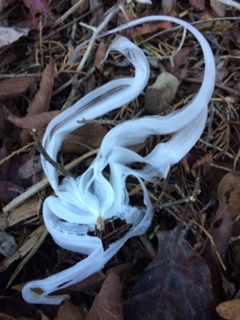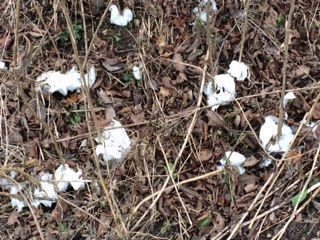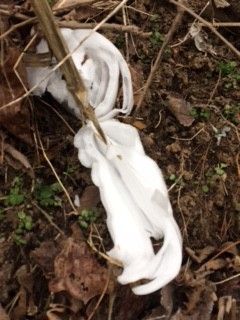
Though quite brisk, visiting here in the Ozarks in the cold winter has its perks. Besides the cold fresh air and sunshine, the beauty of the mountain landscape is always breathtaking, however this time of year, Ozarkians are celebrating the natural phenomena of frost flowers.
Having neve seen a frost flower except in photos, when I recently spied them while riding down an Arkansas highway, I requested with urgency and excitement for my driver and fellow herborizing cohort, Tina Marie Wilcox, to pull over! Then I spent a good deal of time inspecting, photographing and feeling these amazing frozen creations of nature.
“Crystallofolia” is a relatively new term for these botanical ice formations, so named by Bob Harms of the Plant Resource Center, University of Texas, Austin, who has studied frost flowers for many years. (For more info read Steven Foster’s article on https://eureka.news/the-nature-of-eureka-happy-crystallofolia-season/) There are two plants native to this region which produce this unique botanical occurence: white crown-beard (Verbesina virginica), which is often called frostweed and dittany (Cunila origanoides).
The scientific explanation is when temperatures reach freezing or below, the plant sap freezes and bursts or breaks the epidermis of the stems of both of these species of plants. When the stems burst the sap is released and as it spurts through the frigid air it freezes immediately creating frozen ice crystals. Each one is different in shape, just like no two snowflakes are alike. It is rather like poetry in motion–except that the movement of the sap–is captured and frozen in motion.
On this visit to the Ozarks I have seen many patches of frost flowers mostly along roadsides, often in ditches at the edge of woods and they also can be found near creeks and wetlands, most often in shady places.
During the growing season, white crown-beard is rather rangy and weedlike, and can reach up to seven-feet tall; it has white flowers that bloom from late summer to early fall. Their frost flowers can burst from the stems and appear anywhere from ground level and up to one or two feet up the stem. On the other hand, dittany is a smaller plant reaching about one to two foot in height with lavender-or white-hued flowers from midsummer to autumn. The frost flowers on dittany appear right at ground level.
These icy flowers made from solid frozen sap might be fat, round, puffy-looking like cotton candy or appear like frozen ribbons; they are quite extraordinary to behold and I feel so fortunate to have experienced this incredible phenomena, close up and personal.
Do you have these frozen miracles in your growing region?






















Comments
Log in or create an account to post a comment.
Sign up Log in